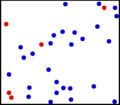Neutron moderator facts for kids
A neutron moderator is a material that slows down neutrons. This is done in nuclear power stations so the neutrons keep a steady nuclear chain reaction to provide heat.
Neutron moderators are an essential part of most nuclear reactors. Common neutron moderators are ordinary water (called light water in the nuclear industry), heavy water, and graphite.
Images for kids
-
In a system at thermal equilibrium, neutrons (red) are elastically scattered by a hypothetical moderator of free hydrogen nuclei (blue), undergoing thermally activated motion. Kinetic energy is transferred between particles. As the neutrons have essentially the same mass as protons and there is no absorption, the velocity distributions of both particles types would be well-described by a single Maxwell–Boltzmann distribution.
-
Fission cross section, measured in barns (a unit equal to 10−28 m2), is a function of the energy (so-called excitation function) of the neutron colliding with a 235U nucleus. Fission probability decreases as neutron energy (and speed) increases. This explains why most reactors fueled with 235U need a moderator to sustain a chain reaction and why removing a moderator can shut down a reactor.
See also
 In Spanish: Moderador nuclear para niños
In Spanish: Moderador nuclear para niños



